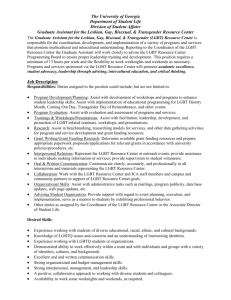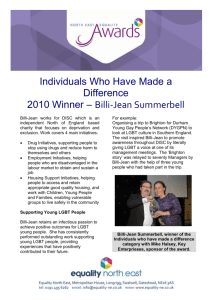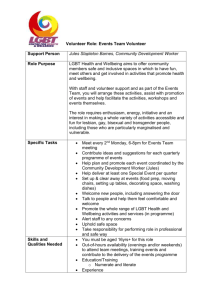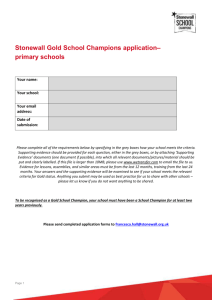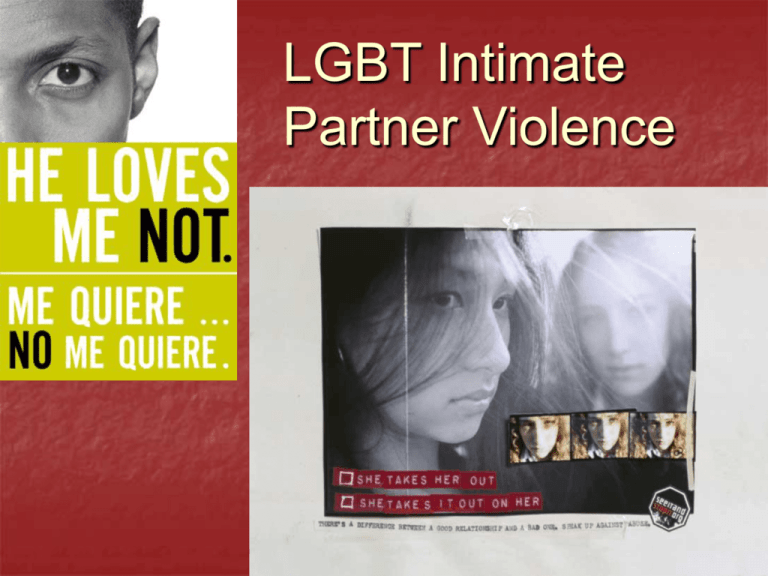
LGBT Intimate
Partner Violence
“Domestic violence is framed as something
about male/female relationships, derived
from sexism, not from a larger framework
of oppressions. I hear all the time, maybe
queer relationship violence is there, but it
can’t be as bad or [as] frequent as in
abusive straight relationships. Even if it is
named, it is minimized.”
-Anonymous Survivor
“Our heterosexual friend complains to us about her
boyfriend's abusive behavior. She says he won't let her talk
to anyone but him, he yells at her and calls her names, he
makes her feel crazy all the time, he isolates her, he
threatens her, and he terrorizes her with words. We tell her
to ditch him. Our lesbian friend tells us about her
girlfriend's abusive behavior, describing it in exactly the
same terms, and we tell her it's a difference in relationship
style. We listen to our father berate our mother, and we tell
her she shouldn't put up with it. We listen to a lesbian
berate another lesbian, and we think, Well, she didn't hit
her. We hear about a friend having been raped by a man,
and we want him in jail at least and preferably dead; we
hear about a woman raping another woman, and we figure
it was just a fantasy gone awry.”—Tess Wiseheart
Part One:
LGBT Intimate Partner
Violence 101
A Definition of Intimate Partner
Violence
A pattern of behaviors utilized by one
partner (the abuser or batterer) to exert
and maintain control over another person
(the survivor or victim) where there exists
an intimate and/or dependent relationship.
Physical, emotional, sexual, financial
Recognizing Signs of Intimate
Partner Violence
One partner consistently humiliates, criticizes,
and/or blames the other for things he/she
cannot control.
One partner slaps, kicks, punches, pushes,
and/or uses weapons against the other.
One partner forces or coerces the other into
sexual activity and/or refuses to practice safe
sex.
Recognizing Signs of Intimate
Partner Violence
One partner forces the other into an environment
where he/she doesn’t feel safe, such as a primarily
heterosexual, non-LGBT friendly establishment and
forces the other into publicly express affection
One partner uses jealousy and anger to control the
other.
One partner controls the other’s money, or wants to
be need for money.
One partner claims to be out of control from
alcohol, drugs, or abusive childhood.
Quick Check List of Abusive
Behaviors: Does Your Partner….
Act jealous & possessive
Try to control you
Intimidate you
Lose her/his temper quickly
Pressure you for sex
Quick Check List of Abusive
Behaviors: Does Your Partner….
Blame you when s/he mistreats you
Threaten to “out” you if you leave the
relationship
Treat your pets or children cruelly
Use or threaten to use a weapon against you
Isolate you from others
FACTS
1 in 4 LGBT individuals are affected by domestic
violence. This is the same rate as heterosexual
women.
LGBT people are more likely to be victims of
domestic violence (including sexual assault) than of
anti-LGBT violence.
Up to 49% of LGBT youth have experience teen
dating violence.
Many acts of domestic violence are a crime under
Ohio law (See Ohio Revised Code 2929.25 and
3113.31)
MYTHS
“Lesbian Utopia”
“Boys will be Boys” and the Myth of Mutual
Battering
LBT women report domestic violence more than
GBT men.
Who is the batterer?
Butch/Femme
Race/Class
Body Size
S/M is a variation of domestic violence
Forms of Battering Specific to
LGBT People
Outing and threats of outing to family,
friends, employer, police, community, or in
child custody disputes.
Reinforcing fears that no one will help the
victim or that they “deserve” the abuse.
Justifying abuse with the notion that partner
is not “really” LGBT.
Forms of Battering Specific to
LGBT People
Telling the partner that abusive behavior is a normal
part of LGBT relationships or that it can’t be DV
because it is occurring between LGBT individuals.
Denying victim access to LGBT resources or events
Portraying the violence as mutual or even
consensual.
Depicting the abuse as part of S/M
Challenges to Dealing with
LGBT Intimate Partner
Violence
Homophobia
Lack of awareness and denial within the LGBT
community
Services are oriented primarily to heterosexual
women
Lack of awareness in the “mainstream” anti-DV
movement.
Underreporting
Fear of disclosure of one’s sexual orientation or
gender expression or of “being outed.”
How is LGBT intimate partner
violence similar to heterosexual
domestic violence?
No one deserves to be abused.
Abuse can be physical, sexual, and verbal
behavior to coerce or humiliate; emotional; or
psychological.
Abuse often occurs in a cyclic fashion.
Abuse can be lethal.
How is LGBT intimate partner
violence similar to heterosexual
domestic violence?
Purpose of the abuse is to maintain control and
power over one’s partner. Routine intimidation
is used to gain that power.
The abused person feels isolated, afraid, and
usually convinced that they are at fault.
The incidence rate in victims of female same sex
battering is approximately the same as the
incidence rate in victims of female heterosexual
victims
How is LGBT intimate partner
violence different?
Some LGBT survivors know few or no other LGBT
folks and leaving the abuser could mean isolation
from LGBT community.
LGBT community may be small and everyone the
survivor knows may soon know of the abuse.
Abuser can use children in relationship because if
survivor leaves, she has no parental rights to kids
If the kids are the survivors, the county may take
the kids away from the “violent, homosexual
deviant”
How is LGBT intimate partner
violence different?
More difficulty finding appropriate support
Myth of mutual battering prevails
Utilizing services such as legal system is like
“coming out”
Hard to find LGBT sympathetic friends since
community may not be eager to “air dirty
laundry”
Part Two:
The Concept of “Help”
Concept of Help: Dynamics
People from a dominant (heterosexual) culture,
tend to assume that if they were a victim, they
would have an automatic right to help.
But
if you are a person from a subdominant
(LGBT) culture, you may not have experienced
agencies as helpful in the past, so you may not
believe that help is available to you and you may
not seek out help.
Concept of Help: Service Providers
Agency
assurances that services
are for everyone may not mean
much to a LGBT person.
LGBT people historically have been
offered “help” to become “normal”,
so they may automatically be
suspicious of “help” from any
institutional representative
Concept of Help: Batterers
LGBT victim/survivor may also view “help” as
involving incriminating the batterer and LGBT
folks may be less likely to do this since it means
“airing dirty laundry” and further marginalizing
an oppressed community member.
Also, research suggests that some LGBT prefer
to have batterers get help (rather than be
ostracized) so that they do not go back into
LGBT community and re-offend.
Concept of Help: Police
LGBT victim may not want to involve police
Deep-rooted fear of police as homophobic
Deep-rooted fear of police not knowing who the
batterer is and not being believed
Deep-rooted fear of police minimizing intimate
partner violence to problems between “two
friends”
Concern if LGBT intimate partner violence falls
under legal definition of “domestic violence”
Concept of Help: Safety
For LGBT victims, “safety” is more than
shelter or protection orders or safety plans
Focus groups suggest that those “safety”
measures rate lower than the ability to
feel safe to be oneself.
To feel believed
To feel unafraid of homophobic, heterosexist
responses and attitudes of service providers
What can you do?
What Can You Do?
Examine dynamics of own relationship
If helping a friend, allow friend to tell her/his
story without being judgmental
Believe your friend
Be sensitive to your friend’s feelings—even if
friend wants to stay with abuser
Inform friend of available resources—e.g. can
call hotline to develop safety plan
Allow friend to make own decisions
Be patient
Resources
YWCA’s Battered Women’s Shelter and Rape
Crisis & Abuse Center PROTECT Hotline
Gay Men’s Domestic Violence Project (national
24 hotline)
888-872-9259
TTY: 513-977-5545
800-832-1901
Women’s Crisis Center (Northern Kentucky)
800-928-3335
TDD: 859-655-2657

